Pressmach 2-IN-1 Compact Straightener and Uncoiler
Decoiler Straightener 2 in 1 Machine
The 2 in 1 decoiler leveling machine integrates the decoiler and the leveling machine as one whole machine. The whole decoiler and straightener adopts the steel frame structure to form one-piece body, which has high leveling precision, compact structure, small floor space, convenient operation advantages, and become the preferred equipment for stamping automated production lines.
Pressmach 2-IN-1 Compact Straightener and Uncoiler provides optimum straightening and excellent value. The modular design can handle a wide range of material widths and thicknesses to increase production capabilities for thin to heavy-duty stamping applications.
Decoiler Straightener 2 in 1 Machine Feature
1. All rollers finished heat treated, hard chrome-plated, ground etc. After this craft, roller hardness comes HRC60-62°
2. Decoiler and straightener machine were combined in one machine, saving factory space and having reduced feeding errors.
3. The leveling adjustment part was adjusted by 4 independent manual wheels at the indicated of 4 rulers.
4. The control box equips with CE certificated low voltage quality components from Schneider, Siemens or Mitsubishi etc.
Type and Working Principle of Decoiler
The decoiler of two-in-one machine
The decoiler of two-in-one machine is divided into two types: power type and non-power type. If the material has high elasticity and big thickness, a pneumatic pressing arm can be added to the decoiler. When the expansion is carried out, the material is pressed tightly to prevent it from being scattered, and at the same time, the friction between the material and the decoiler shingle plate is increased, so as to prevent the material from slipping and wear.
(1) Powered decoiler. The powered type decoiler is driven by the motor through the belt of the reducer, and the main shaft drives the decoiler to rotate, thereby realizing the function of discharging and decoiling. In order to ensure synchronization with the leveling part, the powered decoiler is equipped with a light eye or a 24V frame sensor to control the opening and closing of the decoiler. When the material is drooped to a certain degree of curvature and the frame sensor is touched or the light eye is blocked, the decoiler will immediately stop running. When the material leaves the frame sensor or does not block the light eye, the decoiler will restart to the feeding to realize fully automatic opening and closing.
(2) Unpowered decoiler. The unpowered decoiler is not equipped with an electric box in the decoiler part, and no motor is provided for power. The feeding function is realized by the two-in-one leveling part, and the leveling part pulls the material forward while leveling the material. In order to ensure the stability of the decoiler during operation, the environmental rubber brake is equipped on the main shaft to adjust the tension of the main shaft through the rotation of the hand wheel. By feeling the tightness of the hand wheel and observation of the material to adjust the smoothness of the feeding, thereby eliminating the inertia rotation caused by the leveling part to avoid the looseness of the coil.
Working Principle of Leveling Machine
The leveling part of two-in-one machine
The leveling part of two-in-one machine is composed of transmission part and the base. The transmission mechanism of the leveling machine is composed of a motor, a transmission reducer, a shaft end sprocket of the reducer, a sprocket drive shaft, gears and leveling rollers and feeding rollers. The leveling operation is completed by the feeding rollers and the leveling rollers. Before the leveling adjustment, the feeding rollers need to be adjusted to ensure that the material does not slip when it passes.
In the use of the two-in-one decoiler leveling machine, the leveling adjustment handle should be adjusted according to the thickness and toughness (internal stress) of the material itself to ensure that the raw material meets the leveling requirements. When adjusting, you need to observe the leveling effect. If the effect is not good, you should increase the degree of the pressure from leveling rollers, but pay special attention to the pressing speed and pressing degree should not be too much, otherwise it will cause ripples on both sides of the material and the roller indentation, so the adjustment needs to be carefully managed repeatedly.

